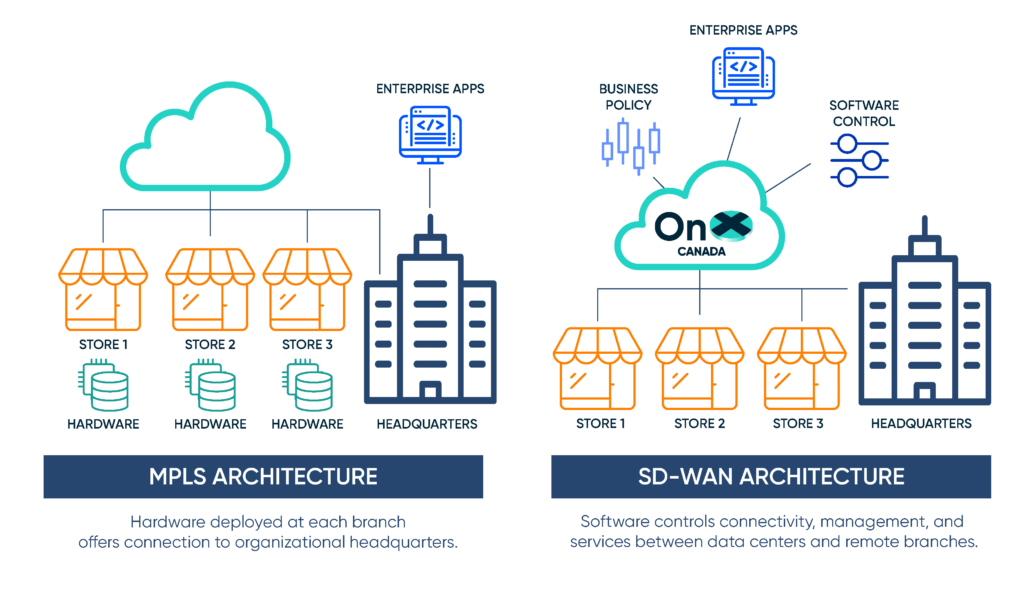
Adopting a software-defined wide area network (SD-WAN) has become critical to modern business operations. This architecture ensures network safety and security even in remote environments, allows IT managers to virtualize their network, simplifies the delivery of services, and far more.
However, organizations still relying on legacy networks may be hesitant to switch to a newer architecture. It requires an infrastructure that many organizations lack, while others may be confused about what this technology is and what it can and cannot do. But precisely what is SD-WAN? This blog will explain its features, why it is vital to grow businesses, and how to choose the right implementation partner.
What is SD-WAN and how does it help your organization?
In simple terms, SD-WAN refers to software and cloud-based technologies that make providing WAN services to branch offices easier. This technology utilizes a centralized control function to safely and efficiently direct traffic to trusted providers across the WAN. SD-WAN simplifies the delivery of networking resources to disparate locations using advanced software and cloud technology. Through this method of software virtualization, enterprises can streamline and abstract their network operations, letting IT experts deploy and manage web-based connections efficiently and safely.
So, what is SD-WAN? It is a lifesaver for busy IT managers, allowing them to deploy Internet-based connectivity more quickly and securely while benefiting from increased application performance. Additionally, it provides a better user experience and raises business productivity, all while reducing IT costs.
Learn more: SD-WAN: Roadmap for software-defined networking
Why is now the time to make the switch?
Business needs are evolving, requiring faster response times and lower latency from applications such as voice over Internet protocol (VoIP). It is no longer sufficient to rely on outdated methods of transporting traffic from branch offices to data centers for inspection. Instead, organizations need a better way to send traffic directly over the Internet while maintaining security.
Companies that rely on multiprotocol label switching (MPLS) networks have to settle for high latency and low-performance cloud applications. These limitations hinder the real-time performance of services, while security and management requirements create bottlenecks and increase IT staffing costs.
However, while SD-WAN will help organizations overcome the limitations of MPLS and meet the needs of increasing customer expectations, they should first understand what it can and can’t do.
What can software-defined wide area networking do for your organization?
The world has moved to hybrid work environments. In this new way of working, SD-WAN provides some key benefits:
- Security: Allows for rapid bandwidth and firewall deployment, reducing the number of IT personnel needed to be on-site.
- Agility: Internet connectivity that is quick to deploy and costs a fraction of MPLS equivalents, allowing organizations to adapt quickly.
- User experience: Connecting through the Internet allows for secure, high-performance connections from branch to cloud–meaning backhaul penalties of MPLS networks are a thing of the past. This connection also means remote users see an improvement in their experience when using cloud/SaaS-based applications.
These are just the beginning of the benefits of software-defined architecture. Simplifying the delivery of services, virtualizing networks, tracking performance or usage, delivering automation, providing a safe overlay, and far more are all made possible through virtualized networking.
Businesses that rely on conventional MPLS systems to transfer traffic between a branch and a centralized data center can benefit significantly from switching to a cloud-based networking model. This modern architecture can provide better and faster access to cloud applications. Network functions will migrate to the Cloud, giving businesses far more efficient visibility of their analytics without having to oversee their infrastructure at a local level. Everything simply becomes more efficient.

Learn more: SD-WAN advantages for your hybrid work-from-home model
What can’t SD-WAN do?
While SD-WAN is a comprehensive and increasingly necessary solution for an organization’s networking needs, there still are features it can’t provide.
SD-WAN will not have the bookended WAN optimization corporations were accustomed to with private MPLS links and TCP-only connections. It will not avoid telecom services as it is not a private, dark-fiber networking solution. It also does not provide multi-link WAN bonding with path control, nor is it a last-mile cloud gateway solution for application-based caching and acceleration techniques. Finally, SD-WAN will not offer a telco backbone that includes multilayer integration of packet and optical networks.
By understanding these limitations, corporations will be better able to ensure that this architecture fulfills their needs.
Also read: SD-WAN delivers better cloud app performance
Constant safety and security in a remote world
As remote workers must access information daily from increasingly spread-out locations, they will quickly become all too familiar with the struggle of insufficient wireless networks and constrained bandwidth.
In addition to enhancing efficiency and agility, SD-WAN offers a secure cloud network with the help of a secure overlay. That means a transport-independent overlay works across any combination of public-private circuits, meaning organizations benefit from connectivity to enterprise data centers and SaaS (Software as a Service) applications.
To increase security even further, these networking solutions can be service-chained with other cloud solutions to protect against a wide range of cyber threats. It protects organizations against phishers, scammers, bots, and more, even when their workers operate remotely. It provides peace of mind and allows workers to complete tasks that will see the organization achieve its goals.
Sectors that benefit the most from SD-WAN
Regardless of location or economic sector, most industries will benefit significantly from SD-WAN, but specific industries see additional benefits.
Some industries, such as retail and food service organizations, have limited budgets for networking infrastructure. Software-defined wide area networks are a good fit for these organizations due to their lower infrastructure costs and ability to maintain connection quality. Similarly, the healthcare industry has unique needs that this service can address. By creating specific policies and customized routing protocols for critical healthcare applications and their large, widely distributed environments, healthcare agencies can benefit from SD-WAN.
Government agencies that manage public-facing entities and receive a high volume of phone calls can streamline their application and service management with SD-WAN, making it easier to manage their local, statewide, or even nationally distributed network environments.
Selecting the right implementation partner
Choosing the right partner when switching to an SD-WAN solution is critical for organizations trying to find a network architecture that will allow them to achieve their business objectives. The switch is not a small task, and providers need expertise in transitioning legacy MPLS networks to cloud-powered hybrid or software-defined wide area network architectures, regardless of industry.
When choosing a partner, ensure the provider will connect with IT to identify vulnerabilities, assess the existing network infrastructure, and develop an optimal transition strategy. The right partner will help maximize the benefits of virtualized technology by offering expertise and modern security solutions to optimize bandwidth and safeguard crucial data and applications.
When you are looking for the right partner to help you with network transformation, it’s crucial to consider providers who have the necessary expertise to seamlessly transition a legacy MPLS network into a cloud-powered hybrid or SD-WAN architecture, regardless of the industry you’re in.
To successfully deploy this solution, you must have total commitment and complete buy-in from your enterprise leaders. Your C-level officers must be aware of the goals of this transition, which requires productive conversations early on in the process.

provider should also be able to work with a client’s IT team to:
- Identify vulnerabilities.
- Map out the existing network environment.
- Plot out an optimal transition plan.
- Support your IT team each step of the way, and seamlessly transition in a support role, post-migration.
Begin your modernized networking journey
The world of enterprise networking is being shaped by SD-WAN technology, both in the present and future. However, having a knowledgeable guide to navigate this rapidly changing landscape is crucial. The right partner should bring a modern approach to an enterprise’s security situation. When an organization asks, “What is SD-WAN?” your partner should be able to go beyond providing a simple overview and demonstrate a deep knowledge of your current network and how to optimize bandwidth while safeguarding essential data. Choose your partner wisely to leverage the full potential of this transformative technology.
Contact an expert from OnX and learn more about how software-defined wide area networking can modernize your network or enhance threat management.
















